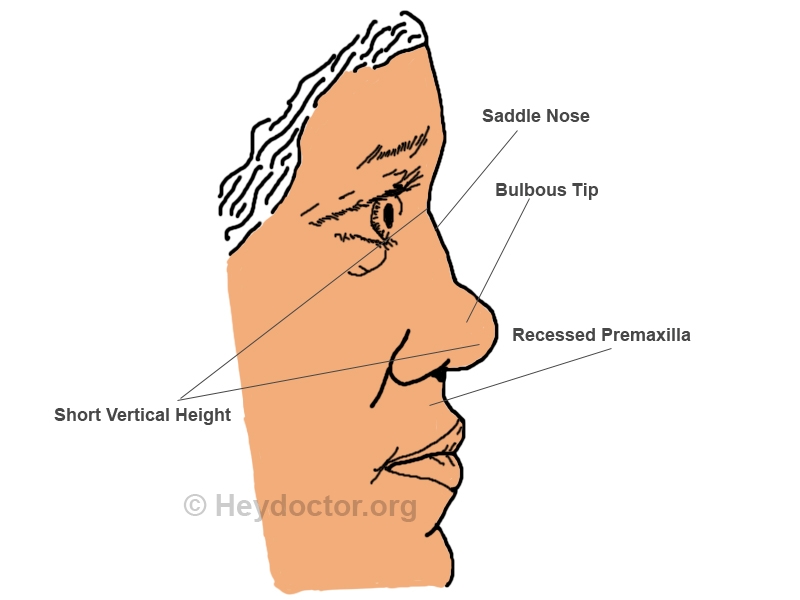What is Saddle Nose deformity?
If you are told that you have a saddle nose, this just means that your nose has a concavity. When you have this type of nose it will generally result in a reduced nasal support and nasal length and aesthetics. The appearance of a saddle nose is that it can give you the appearance of having a pug nose.
- Mild — in this category there is mild nasal collapse that causes a wide and slightly flattened nasal dorsum, unnatural radians, or micro-pits. Your nasal dorsum is the bridge of your nose.
- Moderate — in this category there is an obvious nose collapse. It also considers what the width is of the bridge of your nose section, if your nose sticks in the air, the nasal short and nasal tip stay flat or there is a shorter length of your nose.
- Severe — in this category there is severe depressed nasal dorsum and is usually accompanied by obvious deformity in your nasal septum and nasal structure.
Symptoms of Saddle Nose
Having a saddle nose can cause a variety of problems such as:
- Difficulty breathing
- Nasal obstruction
- Respiratory infections that are recurrent
Saddle Nose Causes

As with symptoms, there are also a variety of causes for having a saddle nose. It usually is a condition that perforates or weakens your nasal septum. There are some causes that are considered “associated with” like associated with genetics. Other examples of associated with cause includes:
- Genetic or hereditary factors can cause a person to have a small or missing a nose having a big nose, or mushroom nose. The abnormal genes are usually passed from one or both parents to the child. The disorders that are caused by these abnormal genes can usually be treated but not cured. One type of hereditary condition is called Cleidocranial Dysostosis, which can cause your collarbone and skull to grow abnormally and possibly have a low nasal bridge. Another form of a genetic condition is called Williams Syndrome Saddle Nose, which is a developmental disorder and can also cause a low nasal bridge. Down syndrome is another genetic cause that can cause a low nasal bridge.
- Infectious diseases like syphilis or leprosy. If a pregnant mother is infected with syphilis she can pass it onto the fetus causing the fetus to have a medical condition called congenital syphilis. One character of congenital syphilis is having a saddle nose along with other characteristics.
- Autoimmune and inflammatory like Wegner’s disease or relapsing perichondritis. With Wegener’s granulomatosis disease the medium and small-sized blood vessels become inflamed and then are destroyed by your own immune cells. Having a saddle nose with this condition comes from the destruction of your nasal septum. Relapsing perichondritis causes the destruction of the cartilaginous structures of your nose and other medical problems.
- Drug abuse or drug induced includes sniffing heroin or cocaine can lead to the formation of perforations or holes in your nasal septum, possibly causing saddle nose. This is usually a notorious cause of having a saddle nose.
- Malignant causes usually include a form of T cell lymphoma that is called lethal midline granulomatous disease. There can also be malignancies in your paranasal sinuses could also metastasize to your nose and lead to a loss of nasal structural integrity causing a saddle nose.
- Previous nasal surgeries or trauma to your nose can also cause a saddle nose. If you have direct trauma to the cartilaginous and/or bony part of your nasal septum they can be destroyed and cause a saddle nose. If you have had previous nasal surgeries or rhinoplasties they can also lead to having a saddle nose.
- Congenital malformations, which appear after the baby is born. It could happen when a pregnant woman is exposed to external factors during childbirth or during the first months of pregnancy.
- Birth defects such as fetal alcohol syndrome (FAS), which can also cause a low nasal bridge.
Diagnosis
When seeking a diagnosis of saddle nose there are four specialists that can make that diagnosis if you have a saddle nose.
- Pediatrician
- Plastic surgeon
- General practitioner
- Geneticist
During your rhinoplasty with any of these specialists, they will review your treatment options for:
- Facial cosmetic surgery
- Septoplasty
- Secondary and primary rhinoplasty
- Repair of your nasal fracture
They will also discuss the pros and cons of each treatment, pre-and post-operative instructions, cost and prices of having rhinoplasty, and esthetic outcomes. During the consultation they will ask you for a list of symptoms and how long you have had them, your medical history, which includes any other medical conditions you have, and supplements or medications you are taking. Generally, they do not take x-rays of your nose because they are not accurate in diagnosing fractures nor are x-rays helpful in deciding what treatment will be necessary.
Treatment
In order to treat this medical condition your physician will need to know what caused it and then determine the degree of saddling. The most common way of treating it is to perform surgery called rhinoplasty. In some instances of saddle nose they will require medical interventions to be fixed.
- If the cause is from congenital syphilis treatment is normally done with taking penicillin or other antibiotics to kill the infection but the treatment has a limited success rate. To help prevent congenital syphilis pregnant women should be screened completely during their pregnancy to treat any symptoms of syphilis before it causes complications in the adult and fetus. If the baby has congenital syphilis and it is not treated it can cause their nose to collapse and the flesh around their nose to rot away.
- For Wegener’s granulomatosis disease it is treated using immunosuppressants and corticosteroids.
- Cleidocranial Dysostosis is treated by taking control of your dorsal septum, which will often require the separation of your upper lateral cartilages and then the placement of spreader grafts. These will open and maintain a valve angle that is satisfactory.
- Williams Syndrome saddle nose can be minimal, moderate, or major. If it is minimal it is treated by extracorporeal rhinoplasty. For moderate saddle nose it will be treated by an inverted U-shape conchal graft and with a major saddle nose costal cartilage was used to reconstruct the nose.
- Down syndrome is usually treated by having rhinoplasty in which there is a partial lifting of the cartilage and bones of their nose. This is normally done at the discretion of the physician in charge.
- Fetal alcohol syndrome can be treated by a cancellous bone graft.
Surgery is done according to what the underlying cause, presence of symptoms, and what the patient’s preference. If there is septal perforation or nasal obstruction and surgery is chosen they will do either rhinoplasty or nasal reconstructive surgery.
Saddle Nose Pictures


Six ways to treat saddle nose
The most common treatment for saddle nose is to have rhinoplasty surgery but there are other ways in which saddle nose can be treated.
Nasal elevation
This is when the physician will elevate the depressed nasal tab with some type of suspension. This treatment will require a mechanical device to apply for retraction to your nose and a head cap. This is not the right treatment if the saddle is associated with a telescoping frontal injury or extensive comminution of the nasal bones
Skin grafting
If the superintendent saddle is small and not very much displacement of your nasal bones this type of deformity may be able to be corrected with a cartilage graft.
Septal manipulation
With this treatment the physician will manipulate the septal structures into the correct alignment. They will then counteract any continuing deformity by force by leaving the in the nasal packing for about a week.
Rib grafts
Using irradiated rib grafts can be gotten from blood banks and then used to build the nasal dorsum. This treatment is used if there is a significant defect of your nasal dorsum that is agreeable for treatment using the conventional grafts from your own cartilage. One of the main reasons that the patient does not want them to harvest from their own rib area.
Silicon droplet technique
This treatment is also called the microdroplet technique can be used for silicone by injecting 0.01 milliliter per droplet with the maximum of eighteen. Any more will put the patient at risk for having a severe granulomatous reaction. The dosage needs to be correct. This method of treatment is controversial and has been associated with infection, small vessel thrombosis, granuloma formation, and skin necrosis. Silicone has been recognized as putting patients at a significant risk of skin necrosis. The benefits versus the risks should be analyzed carefully before choosing this treatment.
Inferior Turbinate Surgery
At the beginning of the surgery the inferior turbinate is dissected and then sectioned using surgical scissors in order to leave intact the periosteum. Using inferior turbinate is a favorable treatment for the reconstruction of saddle nose because it is ready for use without resorption in the long run, low cost, and being readily available.
Material used in saddle nose surgery
With rhinoplasty surgery it is done by filling the dorsum of your nose with bone, a synthetic implant, or cartilage. When using a synthetic implant they are normally of silicon or Teflon, which are considered organic When choosing the material that is to be used for correcting saddle nose it should be low cost, easily obtained, cause minimal tissue reaction and minimal reabsorption by your body. Many surgeons prefer to use grafts of bone or cartilage. Some even prefer to use osteocartilaginous segment that is obtained from ribs seventh, eighth, and ninth. When introducing the graft they do not want to never externally introduce the graft but instead do it via intranasal.
Is surgery always necessary?
If the saddle nose concerns the lower nasal bridge it usually does not cause health problems making plastic surgery not necessary. You should talk to a plastic surgeon if you are not satisfied with your nose’s appearance to find out how having plastic surgery done could reshape your nasal bridge. What results you would get from having surgery would all depend on how much lowering of the nasal bridge would be needed and other facial features.




